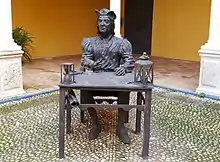Pedro Alonso Niño
Pedro Alonso Niño (c. 1455 – c. 1505) was a Spanish explorer. He piloted the Santa María during Christopher Columbus's first voyage to the Americas in 1492, and accompanied him on his third voyage in 1498 to Trinidad.

Biography
Niño was born in Moguer, an African of mixed heritage, and while some scholars have claimed that Niño was of native African descent,[1][2][3] an investigation of Niño's nickname of "El Negro" concluded it was a transcription error of Niño's last name.[4] He explored the west coast of Africa in his early years.[3] Niño guided Columbus and navigated the Atlantic Ocean as he piloted the Santa María during Christopher Columbus's expedition of 1492,[5] and accompanied him during his third voyage that saw the discovery of Trinidad and the mouths of the Orinoco River. After returning to Spain, Niño made preparations to explore the Indies independently, looking for gold and pearls. Empowered by the Council of Castile to seek out new countries, avoiding those already found by Columbus, he committed to give 20% of his profits for the Spanish Crown (see quinto real).
In the company of brothers Luis and Cristóbal de la Guerra, respectively a rich merchant and a pilot, he left San Lucas in May 1499, and, after twenty-three days, they arrived at Maracapana. Visiting the islands of Isla Margarita, Coche, and Cubagua, they exchanged objects of little value for a large quantity of pearls before sailing up the coast to Punta Araya, where they discovered salt mines.
After just two months they were back in Bayona, Spain, loaded with wealth. However, they were accused of cheating King Ferdinand II out of his portion of the spoils.[3] Arrested, and with his property confiscated, Niño died before the conclusion of his trial.
There is a monument to Pedro Alonso Niño in the Convent of San Francisco in Moguer.[6]
See also
Notes
- Martone, Eric (2008). Encyclopedia of Blacks in European history and culture. Greenwood Press. p. 160. ISBN 978-0313344480.
- Howard, Dodson; Palmer, Colin, eds. (2008). Origins. Michigan State University Press. p. 165. ISBN 978-0870138171.
- "Niño, Pedro Alonso". The New International Encyclopædia. New York: Dodd, Mead and Company. 1905.
- deP. Cassidy, Vincent H. (1959). "Columbus and "The Negro"". The Phylon Quarterly. 20 (3): 294–96. doi:10.2307/273057. JSTOR 273057.
- Alice Bache Gould, Nueva Lista Documentada De Los Tripulantes De Colon En 1492, Boletin de la Real Academia de la Historia, Tomo CLXX, Número II, 1973, passim., including p. 80. However, as noted on p. 293, some near-contemporaries place him as pilot of La Niña.
- Ropero-Regidor, Diego (February 2019). "Los lugares colombinos de Huelva: historia, cultura y naturaleza". Revista PH (in Spanish). Instituto Andaluz del Patrimonio Histórico (96): 58–67. doi:10.33349/2019.96.4292. ISSN 2340-7565.
References
- Rines, George Edwin, ed. (1920). . Encyclopedia Americana. This source gives around 1455 as the year of his birth.
- This article incorporates text from a publication now in the public domain: Wilson, J. G.; Fiske, J., eds. (1900). . Appletons' Cyclopædia of American Biography. New York: D. Appleton.